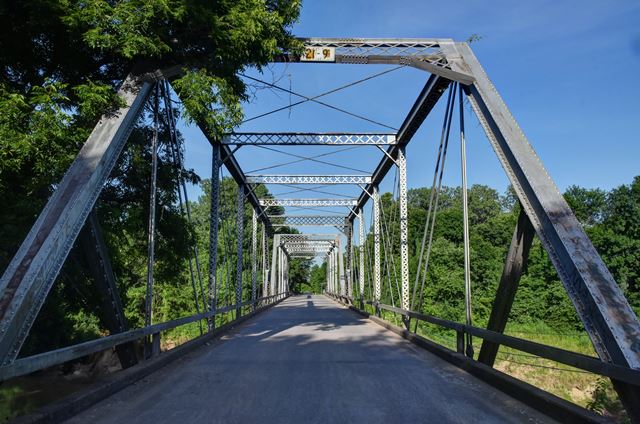We Recommend:
Bach Steel - Experts at historic truss bridge restoration.
BridgeHunter.com Phase 1 is released to the public! - Visit Now
96th Street Bridge

Primary Photographer(s): Nathan Holth
Bridge Documented: June 8, 2016
Rural: Tulsa County, Oklahoma: United States
By Builder/Contractor: Unknown
1936
148.0 Feet (45.1 Meters)
302.5 Feet (92.2 Meters)
20 Feet (6.1 Meters)
2 Main Span(s)
50390000000000

View Information About HSR Ratings
Bridge Documentation
View Archived National Bridge Inventory Report - Has Additional Details and Evaluation
This bridge is an impressive two-span pin-connected through truss. Site evidence as well as the given construction date for this bridge (1936) in the National Bridge Inventory indicate this bridge was relocated here (likely in 1936) and when it was, the bridge was widened as well, as evidenced by spliced details at the center of each portal brace and sway brace. The floorbeams, which appear to be original from the previous location, are also spliced and widened. The deck stringers also appear to be original, apparently sufficient for the bridge even after it was widened.
Research failed to identify where this bridge actually came from. The Oklahoma Bridges website suspects this bridge was originally a railroad bridge. At first casual glance this seems unrealistic, as the members, while massive for a pin-connected highway truss, are not as massive as most pin-connected railroad truss bridges. However, the bridge's use of riveted built-up deck stringers, as well as the use of four eyebars instead of two for each section of lower chord are more typical of railroad bridges, as are the crash bars for the end posts. Perhaps this bridge was originally for a lighter railroad usage, such as an interurban line, or a siding, etc. It doesn't have the mass of a typical mainline freight railroad bridge.
Because the alterations made to widen the bridge are riveted in design it is clear that the widening project occured long ago likely when the bridge was first moved here. The 1936 date given for the construction of this bridge, if accurate, likely refers to the erection of this bridge in this location. The trusses of this bridge are likely much older. The bridge has angles on it with the Oliver Steel name on them. Oliver is one of the rarest company names to find on bridges in North America, and to date has only been seen on angle. Only a couple bridges bearing the Oliver name are dated, one to 1888 and one to 1891. Perhaps this bridge also was originally fabricated and erected in its original location around this time as well. The bridge almost certainly dates to somewhere in the the late 1880s
The bridge is historically and technologically significant as a historical relocation and reuse of a metal truss bridge. It also appears to be a rare example of a 19th Century railroad bridge in Oklahoma. Despite relocation and widening, the truss lines themselves are largely unaltered, and still convey the design and materials of a likely 19th Century truss bridge.
![]()
Photo Galleries and Videos: 96th Street Bridge
Bridge Photo-Documentation
Original / Full Size PhotosA collection of overview and detail photos. This gallery offers photos in the highest available resolution and file size in a touch-friendly popup viewer.
Alternatively, Browse Without Using Viewer
![]()
Bridge Photo-Documentation
Mobile Optimized PhotosA collection of overview and detail photos. This gallery features data-friendly, fast-loading photos in a touch-friendly popup viewer.
Alternatively, Browse Without Using Viewer
![]()
Maps and Links: 96th Street Bridge
Coordinates (Latitude, Longitude):
Search For Additional Bridge Listings:
Bridgehunter.com: View listed bridges within 0.5 miles (0.8 kilometers) of this bridge.
Bridgehunter.com: View listed bridges within 10 miles (16 kilometers) of this bridge.
Additional Maps:
Google Streetview (If Available)
GeoHack (Additional Links and Coordinates)
Apple Maps (Via DuckDuckGo Search)
Apple Maps (Apple devices only)
Android: Open Location In Your Map or GPS App
Flickr Gallery (Find Nearby Photos)
Wikimedia Commons (Find Nearby Photos)
Directions Via Sygic For Android
Directions Via Sygic For iOS and Android Dolphin Browser
USGS National Map (United States Only)
Historical USGS Topo Maps (United States Only)
Historic Aerials (United States Only)
CalTopo Maps (United States Only)

